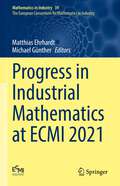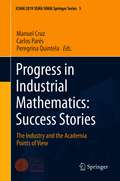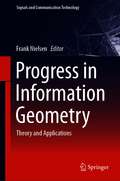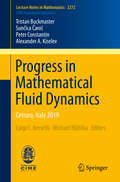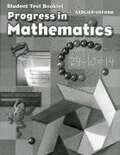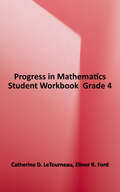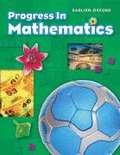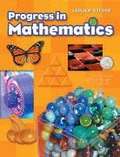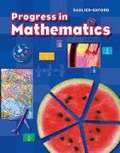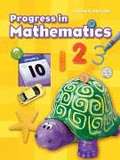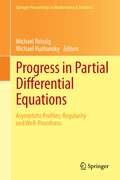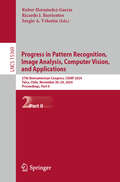- Table View
- List View
Progress in Industrial Mathematics at ECMI 2021 (Mathematics in Industry #39)
by Michael Günther Matthias EhrhardtThis book gathers peer-reviewed contributions submitted to the 21st European Conference on Mathematics for Industry, ECMI 2021, which was virtually held online, hosted by the University of Wuppertal, Germany, from April 13th to April 15th, 2021. The works explore mathematics in a wide variety of applications, ranging from problems in electronics, energy and the environment, to mechanics and mechatronics. Topics covered include: Applied Physics, Biology and Medicine, Cybersecurity, Data Science, Economics, Finance and Insurance, Energy, Production Systems, Social Challenges, and Vehicles and Transportation. The goal of the European Consortium for Mathematics in Industry (ECMI) conference series is to promote interaction between academia and industry, leading to innovations in both fields. These events have attracted leading experts from business, science and academia, and have promoted the application of novel mathematical technologies to industry. They have also encouraged industrial sectors to share challenging problems where mathematicians can provide fresh insights and perspectives. Lastly, the ECMI conferences are one of the main forums in which significant advances in industrial mathematics are presented, bringing together prominent figures from business, science and academia to promote the use of innovative mathematics in industry.
Progress in Industrial Mathematics: The Industry and the Academia Points of View (SEMA SIMAI Springer Series #5)
by Manuel Cruz Peregrina Quintela Carlos ParésThis book presents a panorama about the recent progress of industrial mathematics from the point of view of both industrials and researchers. The chapters correspond to a selection of the contributions presented in the "Industry Day" and in the Minisymposium "EU - MATHS - IN: Success Stories of Applications of Mathematics to Industry" organized in the framework of the International Conference ICIAM 2019 held in Valencia (Spain) on July 15-19, 2019. In the Industry Day, included for the first time in this series of Conferences, representatives of companies from different countries and several sectors presented their view about the benefits regarding the usage of mathematical tools and/or collaboration with mathematicians. The contributions of this special session were addressed to industry people. Minisymposium contributions detailed some collaborations between mathematicians and industrials that led to real benefits in several European companies. All the speakers were affiliated in some of the European National Networks that constitute the European Service Network of Mathematics for Industry and Innovation (EU-MATHS-IN).
Progress in Information Geometry: Theory and Applications (Signals and Communication Technology)
by Frank NielsenThis book focuses on information-geometric manifolds of structured data and models and related applied mathematics. It features new and fruitful interactions between several branches of science: Advanced Signal/Image/Video Processing, Complex Data Modeling and Analysis, Statistics on Manifolds, Topology/Machine/Deep Learning and Artificial Intelligence. The selection of applications makes the book a substantial information source, not only for academic scientist but it is also highly relevant for industry. The book project was initiated following discussions at the international conference GSI’2019 – Geometric Science of Information that was held at ENAC, Toulouse (France).
Progress in Mathematical Fluid Dynamics: Cetraro, Italy 2019 (Lecture Notes in Mathematics #2272)
by Peter Constantin Tristan Buckmaster Sunčica Čanić Alexander A. KiselevThis volume brings together four contributions to mathematical fluid mechanics, a classical but still highly active research field. The contributions cover not only the classical Navier-Stokes equations and Euler equations, but also some simplified models, and fluids interacting with elastic walls. The questions addressed in the lectures range from the basic problems of existence/blow-up of weak and more regular solutions, to modeling and aspects related to numerical methods.This book covers recent advances in several important areas of fluid mechanics. An output of the CIME Summer School "Progress in mathematical fluid mechanics" held in Cetraro in 2019, it offers a collection of lecture notes prepared by T. Buckmaster, (Princeton), S. Canic (UCB) P. Constantin (Princeton) and A. Kiselev (Duke). These notes will be a valuable asset for researchers and advanced graduate students in several aspects of mathematicsl fluid mechanics.
Progress in Mathematics (Grade #5)
by Elinor R. Ford Alfred S. Posamentier Catherine D. LetourneauProgress in Mathematics includes a "handbook" of essential skills, Skills Update, at the beginning of the text. These one-page lessons review skills you learned in previous years.
Progress in Mathematics Gr. 2 Student Test Booklet (Progress in Mathematics, Grade 2)
by Sadlier School*This textbook has been transcribed in UEB, formatted according to Braille textbook formats, proofread and corrected. <P><P>A Perfect Equation for Common Core This comprehensive program supports a transition to a complete Common Core curriculum with a blend of print and digital components. Progress in Mathematics has you covered for: The Common Core State Standards The Eight Standards for Mathematical Practice The Shifts in Mathematics
Progress in Mathematics Student Workbook Grade 4
by Catherine D. LeTourneauEach lesson in Progress in Mathematics has a corresponding page of practice in these workbooks to reinforce lesson objectives and the relevant Common Core State Standards. <p><p>Each includes: - Coherently sequenced lessons with step-by-step instruction to reinforce concepts and skills. - Practice pages that offer exercises for students to apply their knowledge and conceptual understanding of key math concepts. - A Common Core section with additional lessons and practice that focuses on key Common Core State Standards. - Three Performance Tasks that measure a cluster of Common Core State Standards and allow students to demonstrate their understanding of the content standards and show evidence of the Standards for Mathematical Practice.
Progress in Mathematics [Grade 1]
by Alfred Posamentier Catherine Letourneau Elinor FordA publisher-supplied textbook
Progress in Mathematics [Grade 1]
by Elinor R. Ford Alfred S. Posamentier Catherine D. LetourneauA publisher-supplied textbook
Progress in Mathematics [Grade 2]
by Alfred Posamentier Catherine Letourneau Elinor FordA publisher-supplied textbook
Progress in Mathematics [Grade 2]
by Elinor R. Ford Alfred S. Posamentier Catherine D. LetourneauA publisher-supplied textbook
Progress in Mathematics [Grade 3]
by Alfred Posamentier Catherine Letourneau Elinor FordA publisher-supplied textbook
Progress in Mathematics [Grade 3]
by Elinor R. Ford Alfred S. Posamentier Catherine D. LetourneauA publisher-supplied textbook
Progress in Mathematics [Grade 4]
by Alfred Posamentier Catherine Letourneau Elinor FordA publisher-supplied textbook
Progress in Mathematics [Grade 4]
by Elinor R. Ford Alfred S. Posamentier Catherine D. LetourneauA publisher-supplied textbook
Progress in Mathematics [Grade 5]
by Alfred Posamentier Catherine Letourneau Elinor FordA publisher-supplied textbook
Progress in Mathematics [Grade 5]
by Elinor R. Ford Alfred S. Posamentier Catherine D. LetourneauA publisher-supplied textbook
Progress in Mathematics [Grade 6]
by Elinor R. Ford Alfred S. Posamentier Catherine D. LetourneauA publisher-supplied textbook
Progress in Mathematics [Grade K]
by Alfred Posamentier Catherine Letourneau Elinor FordA publisher-supplied textbook
Progress in Mathematics [Grade K]
by Elinor R. Ford Alfred S. Posamentier Catherine D. LetourneauA publisher-supplied textbook
Progress in Partial Differential Equations
by Michael Ruzhansky Michael ReissigProgress in Partial Differential Equations is devoted to modern topics in the theory of partial differential equations. It consists of both original articles and survey papers covering a wide scope of research topics in partial differential equations and their applications. The contributors were participants of the 8th ISAAC congress in Moscow in 2011 or are members of the PDE interest group of the ISAAC society. This volume is addressed to graduate students at various levels as well as researchers in partial differential equations and related fields. The readers will find this an excellent resource of both introductory and advanced material. The key topics are: * Linear hyperbolic equations and systems (scattering, symmetrisers) * Non-linear wave models (global existence, decay estimates, blow-up) * Evolution equations (control theory, well-posedness, smoothing) * Elliptic equations (uniqueness, non-uniqueness, positive solutions) * Special models from applications (Kirchhoff equation, Zakharov-Kuznetsov equation, thermoelasticity)
Progress in Pattern Recognition, Image Analysis, Computer Vision, and Applications: 27th Iberoamerican Congress, CIARP 2024, Talca, Chile, November 26–29, 2024, Proceedings, Part I (Lecture Notes in Computer Science #15368)
by Ruber Hernández-García Ricardo J. Barrientos Sergio A. VelastinThis two-volume set LNCS 15368-15369 constitutes the refereed proceedings of the 27th Iberoamerican Congress on Progress in Pattern Recognition, Image Analysis, Computer Vision, and Applications, CIARP 2024, held in Talca, Chile, during November 26-29, 2024. The 35 full and 3 short papers presented in these proceedings were carefully reviewed and selected from 61 submissions. The papers presented in these two volumes are clustered into various thematical issues as follows: Part I: Mathematical methods and computing techniques for artificial intelligence and pattern recognition, bioinformatics. Part II: Biometrics, cognitive and humanoid vision, computer vision, image analysis, intelligent data analysis.
Progress in Pattern Recognition, Image Analysis, Computer Vision, and Applications: 27th Iberoamerican Congress, CIARP 2024, Talca, Chile, November 26–29, 2024, Proceedings, Part II (Lecture Notes in Computer Science #15369)
by Ruber Hernández-García Ricardo J. Barrientos Sergio A. VelastinThis two-volume set LNCS 15368-15369 constitutes the refereed proceedings of the 27th Iberoamerican Congress on Progress in Pattern Recognition, Image Analysis, Computer Vision, and Applications, CIARP 2024, held in Talca, Chile, during November 26-29, 2024. The 35 full and 3 short papers presented in these proceedings were carefully reviewed and selected from 61 submissions. The papers presented in these two volumes are clustered into various thematical issues as follows: Part I: Mathematical methods and computing techniques for artificial intelligence and pattern recognition, bioinformatics. Part II: Biometrics, cognitive and humanoid vision, computer vision, image analysis, intelligent data analysis.
Progress in Political Geography (Routledge Revivals)
by Michael PacioneSince the 1970s, the field of political geography has undergone a significant transformation, where new methodologies have been implemented to investigate the exercise of the power of the state within the urban environment. First published in 1985, the essays in this collection addressed the growing need to assess the academic revisions that had been taking place and provide a reference point for future developments in the discipline. Still of great relevance, the essays consider the most prominent themes in areas of key importance to political geography, including theory and methodology, minority groups, local government and the geography of elections. This volume will be of significant value for students of political geography, urban demography and town planning.
